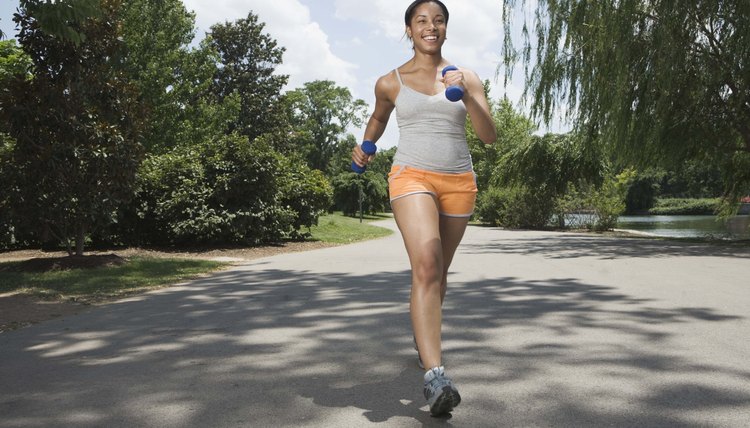How Many Calories Burned in 40 Minutes of Walking & Running?

A calorie can be defined as the energy unit supplied by food, according to the Centers for Disease Control. Your body uses the calories from food to produce energy for bodily functions. However, when you eat more calories than your body needs, the extra calories are stored as fat, and as a result you gain weight. Adding 40 minutes of walking or running each day can help burn this fat.
Exercise and Calorie Burning
Your exercise duration, intensity and your body weight all impact the amount of calories you burn while walking or running. Your exercise intensity has the greatest effect on the amount of calories you burn during the 40 minutes. You can increase your exercise intensity by increasing your workout pace and resistance. The more work you do -- by running or walking uphill or using weights -- the more calories you will burn and the more weight you will lose.
Walking for 40 Minutes
Walking is a low-impact exercise but can burn a good number of calories when done with moderate or high intensity. A 125-pound person walking at 3.5 mph for 40 minutes burns around 160 calories. Increasing your walking pace to 4.5 mph will increase your calorie burn to 200 calories. In addition, walking uphill or while carrying a load increases your calorie burn. Besides your walking intensity, your body weight will have a slight affect on the amount of calories you burn during your walk. The more you weigh, the more work your body needs to do to move.
Running for 40 Minutes
Running is also an aerobic activity that improves your cardiovascular system and burns calories. Again, your running intensity plays a huge role in the amount of calories you burn. Generally, you burn more calories when running compared to walking because your body has to do more work. Running at 5 mph for 40 minutes burns around 345 calories for a 125-pound person. Running at 7.5 mph burns 500 calories, and running at 8.6 mph burns around 580 calories.
Calories Vs. Weight Loss
The number of calories you burn translates to the amount of weight you lose. According to the Centers for Disease Control and Prevention, when you create a calorie deficit of 3,500 calories, you lose 1 lb. of fat. You need to cut 500 calories per day to lose 1 lb. of fat each week. As long as you eat a balanced diet, adding running or walking to your weekly routine can increase your body's energy usage and lead to weight loss.
References
- Centers for Disease Control and Prevention: Balancing Calories
- Calorie Burners: Activities that turn up the heat. American Council on Exercise
- Li SSW, Chan OHT, Ng TY, et al. Gender Differences in Energy Expenditure During Walking With Backpack and Double-Pack Loads. Hum Factors. 2018;:18720818799190. doi:10.1177/0018720818799190
- Chang CH, Lin KC, Ho CS, Huang CC. Accuracy of the energy expenditure during uphill exercise measured by the Waist-worn ActiGraph. J Exerc Sci Fit. 2019;17(2):62-66. doi:10.1016/j.jesf.2019.01.003
- Champagne CM, Broyles ST, Moran LD, et al. Dietary intakes associated with successful weight loss and maintenance during the Weight Loss Maintenance trial. J Am Diet Assoc. 2011;111(12):1826-35. doi:10.1016/j.jada.2011.09.014
- LAYDEN, J. D., PATTERSON, M. J., & NIMMO, M. A. (2002). Effects of reduced ambient temperature on fat utilization during submaximal exercise. Medicine & Science in Sports & Exercise, 34(5), 774–779. doi:10.1097/00005768-200205000-00008
- Li, S. S. W., Chan, O. H. T., Ng, T. Y., Kam, L. H., Ng, C. Y., Chung, W. C., & Chow, D. H. K. (2018). Gender Differences in Energy Expenditure During Walking With Backpack and Double-Pack Loads. Human Factors: The Journal of the Human Factors and Ergonomics Society, 61(2), 203–213. doi:10.1177/0018720818799190
- Michael N. Sawka,1 C. Bruce Wenger, Andrew J. Young, and Kent B. Pandolf. Physiological Responses to Exercise in the Heat. Copyright 1993 by the National Academy of Sciences. All rights reserved.
- Morio, B., Beaufrere, B., Montaurier, C., Verdier, E., Ritz, P., Fellmann, N., … Vermorel, M. (1997). Gender differences in energy expended during activities and in daily energy expenditure of elderly people. American Journal of Physiology-Endocrinology and Metabolism, 273(2), E321–E327. doi:10.1152/ajpendo.1997.273.2.e321
- Yue, A. S. Y., Woo, J., Ip, K. W. M., Sum, C. M. W., Kwok, T., & Hui, S. S. C. (2007). Effect of age and gender on energy expenditure in common activities of daily living in a Chinese population. Disability and Rehabilitation, 29(2), 91–96. doi:10.1080/09638280600662232
- Ainsworth, B.; Haskell, W.; Herrmann, S. et al. Compendium of Physical Activities: A Second Update of Codes and MET Values. Med Sci Sports Exercise. 2011;43:1575. DOI: 10.1249/MSS.0b013e31821ece12.
- American Council on Exercise. (2009) Fit Facts - Calories Burners: Activities That Turn Up the Heat. San Diego, California: American Council on Exercise.
Writer Bio
Maria Parepalo began writing professionally in 2006 and has published in medical journals as well as online. She graduated with a bachelor’s degree in laboratory sciences from Helsinki Polytechnic in 2002 and is currently working on her doctoral degree in cell and molecular biology.
